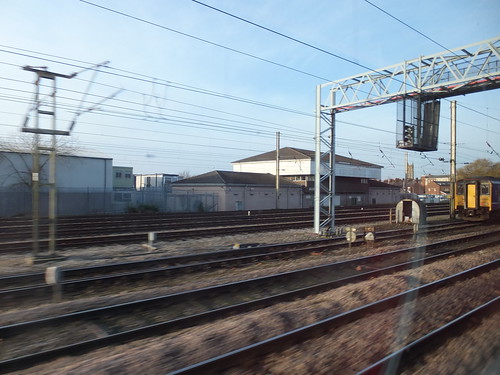But when I started (unofficially) visiting railway signalboxes as described here, I discovered even earlier telecommunications systems (owned and operated by British Rail) still in use. The block system in use for securing the safe passage of trains from signalman to signalman used an arrangement of single-needle telegraph instruments with codes transmitted by single-stroke electric bells (as outlined in the post here). Telephones used were rather primitive, Local Battery affairs in wooden cases.

Local Battery Omnibus Telephone in wooden cabinet with hinging front. Tiltable carbon microphone and cord-mounted receiver stowed on cradle switch, D.C. bell on backboard. Polarised D.C. ringing-out on two buttons.
The GPO were introducing Subscriber Trunk Dialling into the public network (where customers set up their own long-distance calls without the intervention of an Operator), using 'Step-by-Step' Strowger technology. The first Subscriber Trunk Dialling (STD) call in the United Kingdom was made by Her Majesty Queen Elizabeth II on 5th December 1958. There's a brief introduction at Subscriber Trunk Dialling (STD) and a Wikipedia article here.
In 1959, the GPO introduced a 'modern' telephone instrument, still featuring a rotary dial. This formed the basis for what became an extensive range of models - the 700-series. Later members of the 700-series even featured push-button dialling! There's an interesting article on the 700-series instruments on Wikipedia here.
In the post The World of Work I talked about working for Contactor Switchgear (Electronics) Limited. The Sales Director had a number of contacts within British Railways and we bid for a number of telephone-related jobs, without any conspicuous success.
In 1966, I decided to set up in business on my own, as outlined in the post Starting my own business. Getting established proved quite difficult and I was quite happy to accept a variety of work. But an introduction to Gerry Gardner led to sub-contract design and manufacture of specialist telecommunications equipment for emergency services. Following the success of this equipment, we were invited to bid for the supply of selective call telephone equipment by British Rail. Manufacture of the resulting contracts led to a period of expansion and development of similar equipment for use as Electrification Telephone systems for British Rail, as described in the post Electrification Telephone Systems for British Rail. Subsequent schemes were supplied to British Rail and other companies like Westinghouse Brake and Signal.

Our equipment was installed in various Power Signal Boxes, including Preston shown in 2013
G.E.C. in Coventry asked us to design and supply telecommunications equipment for a large railway electrification project in Taiwan. Working for the Big Boys mentions some of my experiences and the report here has some recollections from my first visit to Taiwan to assist with commissioning this scheme.
Although we continued to do work in industrial automation (see Visiting Steelworks and Oil & Gas Industry) most work was channeled into telecommunications for railways. British Rail operated a number of large 'Step-by-Step' exchanges to handle internal telephone traffic and they designed their own version of STD (which they called Extension Trunk Dialling) to link these exchanges into one system. We were kept busy maufacturing the racks and relay sets for this scheme.
Two more large projects for G.E.C. followed - one in Brazil, the second in Thailand. These are briefly described in the post Work (part 2). A proposed commissioning visit to Brazil was cancelled at short notice so I didn't get to Brazil until my 'Round the World Two' trip in 2006 (very briefly described here). But I did visit Thailand a number of times during commissioning of that project (the post here outlines the scope, the post here includes a description of a day fault-finding travelling on a railway trolley and the post Thai Railfan Club describes some of the friendships I made).
Standard Telephones and Cables approached us about a complex railway telephone system for use in the Bombay area. We offered to build suitable equipment, but they were keen to manufacture 'in house' so, in the end, we concluded a license agreement. This involved visits to their manufacturing site in South Wales but I was disappointed not to be involved in commissioning the equipment in Bombay - I didn't get to India until 1992 when we commissioned equipment we'd supplied to G.E.C. for a railway telephone system in the Delhi area (see the post My first trip to India).
When we were asked in 1993 to quote G.E.C. for Tunnel Telephone equipment for the Jubilee Line Extension of London Underground, I initially baulked at the idea. None of our existing designs seemed adaptable and, despite the system name, the main function is to provide a high-integrity emergency traction shutdown system. The design challenge appealed to me but I initially assumed the development cost would make our offer uneconomic, as explained in the post Work (part 2). G.E.C. persisted and the supply of Tunnel Telephone equipment became an important, if erratic, source of business but it's so specialised that I tend to think of it as distinct from 'Telecommunications and Jan'. But there is a post called London Underground and Jan.
Related posts on this website
Selecting label 'Work' (or Clicking here) will display all my posts on 'Work' in reverse date-of-posting order. Alternately, Clicking here will display an index list of Titles of posts labelled 'Work' (but this list may not be up-to-date).
[Link URL corrected 26-Nov-2020]
